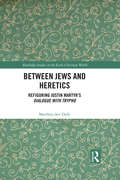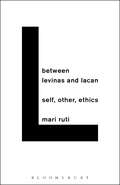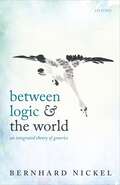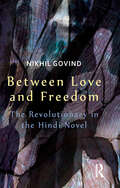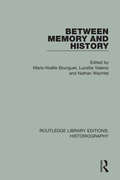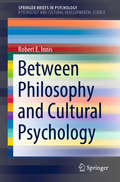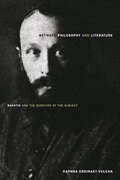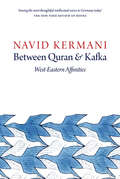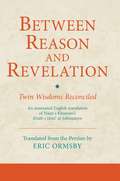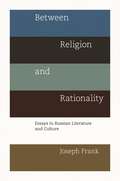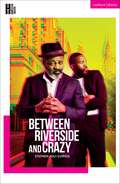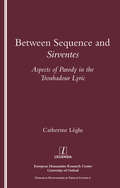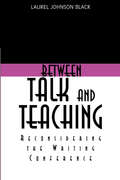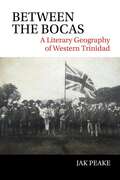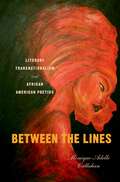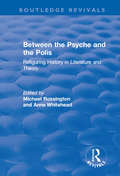- Table View
- List View
Between Jews and Heretics: Refiguring Justin Martyr’s Dialogue with Trypho (Routledge Studies in the Early Christian World)
by Matthijs den DulkJustin Martyr’s Dialogue with Trypho is the oldest preserved literary dialogue between a Jew and a Christian and a key text for understanding the development of early Judaism and Christianity. In Between Jews and Heretics, Matthijs den Dulk argues that whereas scholarship has routinely cast this important text in terms of "Christianity vs. Judaism," its rhetorical aims and discursive strategies are considerably more complex, because Justin is advocating his particular form of Christianity in constant negotiation with rival forms of Christianity. The striking new interpretation proposed in this study explains many of the Dialogue’s puzzling features and sheds new light on key passages. Because the Dialogue is a critical document for the early history of Jews and Christians, this book contributes to a range of important questions, including the emergence of the notion of heresy and the "parting of the ways" between Jews and Christians.
Between Levinas and Lacan: Self, Other, Ethics
by Mari RutiLevinas and Lacan, two giants of contemporary theory, represent schools of thought that seem poles apart. In this major new work, Mari Ruti charts the ethical terrain between them. At first glance, Levinansian and Lacanian approaches may seem more or less incompatible, and in many ways they are, particularly in their understanding of the self-other relationship. For both Levinas and Lacan, the subject's relationship to the other is primary in the sense that the subject, literally, does not exist without the other, but they see the challenge of ethics quite differently: while Levinas laments our failure to adequately meet the ethical demand arising from the other, Lacan laments the consequences of our failure to adequately escape the forms this demand frequently takes. Although this book outlines the major differences between Levinas and Judith Butler on the one hand and Lacan, Slavoj Žižek, and Alain Badiou on the other, Ruti proposes that underneath these differences one can discern a shared concern with the thorny relationship between the singularity of experience and the universality of ethics. Between Levinas and Lacan is an important new book for anyone interested in contemporary theory, ethics, psychoanalysis, and feminist and queer theory.
Between Levinas and Lacan: Self, Other, Ethics
by Mari RutiLevinas and Lacan, two giants of contemporary theory, represent schools of thought that seem poles apart. In this major new work, Mari Ruti charts the ethical terrain between them. At first glance, Levinansian and Lacanian approaches may seem more or less incompatible, and in many ways they are, particularly in their understanding of the self-other relationship. For both Levinas and Lacan, the subject's relationship to the other is primary in the sense that the subject, literally, does not exist without the other, but they see the challenge of ethics quite differently: while Levinas laments our failure to adequately meet the ethical demand arising from the other, Lacan laments the consequences of our failure to adequately escape the forms this demand frequently takes. Although this book outlines the major differences between Levinas and Judith Butler on the one hand and Lacan, Slavoj Žižek, and Alain Badiou on the other, Ruti proposes that underneath these differences one can discern a shared concern with the thorny relationship between the singularity of experience and the universality of ethics. Between Levinas and Lacan is an important new book for anyone interested in contemporary theory, ethics, psychoanalysis, and feminist and queer theory.
Between Logic and the World: An Integrated Theory of Generics
by Bernhard NickelBetween Logic and the World presents a theory of generic sentences and the kind-directed modes of thought they express. The theory closely integrates compositional semantics with metaphysics to solve the problem that generics pose: what do generics mean? Generic sentences are extremely simple, yet if there are patterns to be discerned in terms of which are true and which are false, these patterns are subtle and complex. Ravens are black, lions have manes, sea-turtles are long-lived, and bishops in chess move along diagonals. Statistical measures cannot do justice to the facts, but what else is there that at least has a hope of giving us insight into what we are capturing across so many domains? Bernhard Nickel argues that generics are the top of a fundamentally explanatory iceberg. By focusing on blackness in ravens and manes in lions, for instance, we can place the kinds into a framework structured by explanatory considerations. Between Logic and the World argues that this explanatory framework is deeply intertwined with the semantics of the language we use to express them, and in giving its integrated semantic and metaphysical theory of generics, it aims to solve old puzzles and draw attention to new phenomena.
Between Love and Freedom: The Revolutionary in the Hindi Novel
by Nikhil GovindBetween Love and Freedom interprets the figure of the revolutionary in the Hindi novel by establishing its lineage in representative Bengali novels, as well as in the contending moralities of Mahatma Gandhi and Bhagat Singh on the idea of violence. It reveals how conventional social realism and emergent modernist modes were brought together in the novelistic tradition by extending the political ideal of anti-colonial revolution into domains of sexual desire and subjective expression, especially in the works of Agyeya, Jainendra, and Yashpal. This work will deeply interest scholars and students of literature, modern Indian history, Hindi, and political science.
Between Love and Freedom: The Revolutionary in the Hindi Novel
by Nikhil GovindBetween Love and Freedom interprets the figure of the revolutionary in the Hindi novel by establishing its lineage in representative Bengali novels, as well as in the contending moralities of Mahatma Gandhi and Bhagat Singh on the idea of violence. It reveals how conventional social realism and emergent modernist modes were brought together in the novelistic tradition by extending the political ideal of anti-colonial revolution into domains of sexual desire and subjective expression, especially in the works of Agyeya, Jainendra, and Yashpal. This work will deeply interest scholars and students of literature, modern Indian history, Hindi, and political science.
Between Memory and History (Routledge Library Editions: Historiography #6)
by Marie-Noëlle Bourguet Lucette Valensi Nathan WachtelThe recent wave of interest in oral history and return to the active subject as a topic in historical practice raises a number of questions about the status and function of scholarly history in our societies. This articles in this volume, originally pubished in 1990, and which originally appeared in History and Anthropology, Volume 2, Part 2, discuss what contributions, meanings and consequences emerge from scholarly history turning to living memory, and what the relationships are between history and memory.
Between Memory and History (Routledge Library Editions: Historiography)
by Marie-Noëlle Bourguet Lucette Valensi Nathan WachtelThe recent wave of interest in oral history and return to the active subject as a topic in historical practice raises a number of questions about the status and function of scholarly history in our societies. This articles in this volume, originally pubished in 1990, and which originally appeared in History and Anthropology, Volume 2, Part 2, discuss what contributions, meanings and consequences emerge from scholarly history turning to living memory, and what the relationships are between history and memory.
Between Philosophy and Cultural Psychology (SpringerBriefs in Psychology)
by Robert E. InnisThis Brief provides an in-depth discussion of five major points of intersection between philosophy and cultural psychology. The first chapter frames central analytical and normative threads, foregrounding the focal notion of thresholds of sense. The second chapter explores the nature of contexts, situations, and backgrounds of meaning-making following the lead of John Dewey, Ben-Ami Scharfstein, and Gernot Böhme. Chapter three examines the complementary analytical power of the semiotic resources developed in the work of Peirce, Bühler, and Cassirer. Chapter four shows the heuristic fertility and psychological bearing of Susanne Langer's feeling-based aesthetic model of minding. The final chapter establishes affectivation as the inescapable consequence of human beings giving life to themselves by giving life to signs. The Brief concludes with three commentaries from leading researchers in the area. The chapters weave together interlocking themes: the nature of embodied perception, the variety of contexts and semiotic frameworks and their schematization of thresholds of meaning-making, the role of art and theories of imagination both in cultural psychology and in philosophy, and the centrality of feeling in all forms of meaning-making. Between Philosophy and Cultural Psychology will be of interest to cognitive and cultural psychologists as well as researchers and upper-graduate students in philosophy and related psychology fields.
Between Philosophy and Literature: Bakhtin and the Question of the Subject
by Daphna Erdinast-VulcanThis is an original reading of Mikhail Bakhtin in the context of Western philosophical traditions and counter-traditions. The book portrays Bakhtin as a Modernist thinker torn between an ideological secularity and a profound religious sensibility, invariably concerned with questions of ethics and impelled to turn from philosophy to literature as another way of knowing. Most major studies of Bakhtin highlight the fragmented and apparently discontinuous nature of his work. Erdinast-Vulcan emphasizes, instead, the underlying coherence of the Bakhtinian project, reading its inherent ambivalences as an intersection of philosophical, literary, and psychological insights into the dynamics of embodied subjectivity. Bakhtin's turn to literature and poetry, as well as the dissatisfactions that motivated it, align him with three other "exilic" Continental philosophers who were his contemporaries: Bergson, Merleau-Ponty, and Levinas. Adopting Bakhtin's own open-ended approach to the human sciences, the book stages a series of philosophical encounters between these thinkers, highlighting their respective itineraries and impasses, and generating a Bakhtinian synergy of ideas.
Between Quran and Kafka: West-Eastern Affinities
by Navid KermaniWhat connects Shiite passion plays with Brecht's drama? Which of Goethe's poems were inspired by the Quran? How can Ibn Arabi's theology of sighs explain the plays of Heinrich von Kleist? And why did the Persian author Sadeq Hedayat identify with the Prague Jew Franz Kafka? 'One who knows himself and others will here too understand: Orient and Occident are no longer separable': in this new book, the critically acclaimed author and scholar Navid Kermani takes Goethe at his word. He reads the Quran as a poetic text, opens Eastern literature to Western readers, unveils the mystical dimension in the works of Goethe and Kleist, and deciphers the political implications of theatre, from Shakespeare to Lessing to Brecht. Drawing striking comparisons between diverse literary traditions and cultures, Kermani argues for a literary cosmopolitanism that is opposed to all those who would play religions and cultures against one another, isolating them from one another by force. Between Quran and Kafka concludes with Kermani's speech on receiving Germany's highest literary prize, an impassioned plea for greater fraternity in the face of the tyranny and terrorism of Islamic State. Kermani's personal assimilation of the classics gives his work that topical urgency that distinguishes universal literature when it speaks to our most intimate feelings. For, of course, love too lies 'between Quran and Kafka'.
Between Quran and Kafka: West-Eastern Affinities
by Navid KermaniWhat connects Shiite passion plays with Brecht's drama? Which of Goethe's poems were inspired by the Quran? How can Ibn Arabi's theology of sighs explain the plays of Heinrich von Kleist? And why did the Persian author Sadeq Hedayat identify with the Prague Jew Franz Kafka? 'One who knows himself and others will here too understand: Orient and Occident are no longer separable': in this new book, the critically acclaimed author and scholar Navid Kermani takes Goethe at his word. He reads the Quran as a poetic text, opens Eastern literature to Western readers, unveils the mystical dimension in the works of Goethe and Kleist, and deciphers the political implications of theatre, from Shakespeare to Lessing to Brecht. Drawing striking comparisons between diverse literary traditions and cultures, Kermani argues for a literary cosmopolitanism that is opposed to all those who would play religions and cultures against one another, isolating them from one another by force. Between Quran and Kafka concludes with Kermani's speech on receiving Germany's highest literary prize, an impassioned plea for greater fraternity in the face of the tyranny and terrorism of Islamic State. Kermani's personal assimilation of the classics gives his work that topical urgency that distinguishes universal literature when it speaks to our most intimate feelings. For, of course, love too lies 'between Quran and Kafka'.
Between Reason and Revelation: Twin Wisdoms Reconciled (Ismaili Texts and Translations)
by Eric OrmsbyI.B.Tauris in association with the Institute of Ismaili Studies This is the first English translation of the final philosophical work of the great eleventh-century Ismaili thinker, poet, and Fatimid emissary, N?sir-i Khusraw. Appointed from Cairo by command of the Fatimid Imam-caliph al-Mustansir to serve first as a d?'?, and then as the hujjat, for the entire region of Khur?s?n, he maintained his allegiance both to his mission and his Imam-caliph for the rest of his life, even when threatened and driven into exile. Writtenduring his exile in Badakhsh?n in the year 1070, N?sir-i Khusraw here develops a powerful presentation of both Aristotelian philosophy and Ismaili exegesis, or ta'w?l, and strives to show that they are ultimately in harmony. The work is presented as a learned commentary on a long philosophical poem, written in the previous century and sent to N?sir by the am?r of Badakhsh?n, 'Al? b. al-Asad, who copied the poem out in his own hand from memory and asked the poet-philosopher to explicate it. In doing so, N?sir ranges over a huge span of topics from logic and language to the nature of the physical world, from the spheres of the highest heavens to the plants and animals of the earthly realm, and, most importantly, hidden spiritual realities: the esoteric (b?tin) as well as the exoteric (z?hir) realms. He thus discusses the nature of God, the creation of human beings, and the mysteries concealed in the physical world, itself a reflection of a higher, transcendent realm.Between Reason and Revelation: Twin Wisdoms Reconciled is an annotated translation of the Persian text prepared by Henry Corbin and Mohammed Mu'?n based on the single surviving manuscript of the work, now in the Süleymaniye Mosque Library in Istanbul. It is a work of great philosophical and spiritual insight, which is also a pioneering attempt to tackle difficultintellectual problems in the Persian language; it is at once lucid and lyrical, precise and speculative. N?sir's influence has been immense as both a poet and a thinker, and the Kit?b-i J?mi' al-hikmatayn is his crowning work.
Between Religion and Rationality: Essays in Russian Literature and Culture (PDF)
by Joseph FrankIn this book, acclaimed Dostoevsky biographer Joseph Frank explores some of the most important aspects of nineteenth and twentieth century Russian culture, literature, and history. Delving into the distinctions of the Russian novel as well as the conflicts between the religious peasant world and the educated Russian elite, Between Religion and Rationality displays the cogent reflections of one of the most distinguished and versatile critics in the field. Frank's essays provide a discriminating look at four of Dostoevsky's most famous novels, discuss the debate between J. M. Coetzee and Mario Vargas Llosa on the issue of Dostoevsky and evil, and confront Dostoevsky's anti-Semitism. The collection also examines such topics as Orlando Figes's sweeping survey of the history of Russian culture, the life of Pushkin, and Oblomov's influence on Samuel Beckett. Investigating the omnipresent religious theme that runs throughout Russian culture, even in the antireligious Chekhov, Frank argues that no other major European literature was as much preoccupied as the Russian with the tensions between religion and rationality. Between Religion and Rationality highlights this unique quality of Russian literature and culture, offering insights for general readers and experts alike.
Between Religion and Rationality: Essays in Russian Literature and Culture
by Joseph FrankIn this book, acclaimed Dostoevsky biographer Joseph Frank explores some of the most important aspects of nineteenth and twentieth century Russian culture, literature, and history. Delving into the distinctions of the Russian novel as well as the conflicts between the religious peasant world and the educated Russian elite, Between Religion and Rationality displays the cogent reflections of one of the most distinguished and versatile critics in the field. Frank's essays provide a discriminating look at four of Dostoevsky's most famous novels, discuss the debate between J. M. Coetzee and Mario Vargas Llosa on the issue of Dostoevsky and evil, and confront Dostoevsky's anti-Semitism. The collection also examines such topics as Orlando Figes's sweeping survey of the history of Russian culture, the life of Pushkin, and Oblomov's influence on Samuel Beckett. Investigating the omnipresent religious theme that runs throughout Russian culture, even in the antireligious Chekhov, Frank argues that no other major European literature was as much preoccupied as the Russian with the tensions between religion and rationality. Between Religion and Rationality highlights this unique quality of Russian literature and culture, offering insights for general readers and experts alike.
Between Religion and Rationality: Essays in Russian Literature and Culture
by Joseph FrankIn this book, acclaimed Dostoevsky biographer Joseph Frank explores some of the most important aspects of nineteenth and twentieth century Russian culture, literature, and history. Delving into the distinctions of the Russian novel as well as the conflicts between the religious peasant world and the educated Russian elite, Between Religion and Rationality displays the cogent reflections of one of the most distinguished and versatile critics in the field. Frank's essays provide a discriminating look at four of Dostoevsky's most famous novels, discuss the debate between J. M. Coetzee and Mario Vargas Llosa on the issue of Dostoevsky and evil, and confront Dostoevsky's anti-Semitism. The collection also examines such topics as Orlando Figes's sweeping survey of the history of Russian culture, the life of Pushkin, and Oblomov's influence on Samuel Beckett. Investigating the omnipresent religious theme that runs throughout Russian culture, even in the antireligious Chekhov, Frank argues that no other major European literature was as much preoccupied as the Russian with the tensions between religion and rationality. Between Religion and Rationality highlights this unique quality of Russian literature and culture, offering insights for general readers and experts alike.
Between Riverside and Crazy (Modern Plays)
by Stephen Adly Guirgis"Son, that girl, she's a nice girl, but she don't study accounting. Her lips move when she read the horoscope – that ain't the mark of a future accountant!"Since his wife died, ex-cop Walter 'Pops' Washington has filled his palatial rent-controlled apartment in one of Manhattan's most desirable areas with an oddball extended family of petty criminals. So now he's besieged by the landlords, who want him out, the NYPD, who want him to settle his lawsuit against them, and the ladies from the local church, who want to save his soul… But Pops, calm at the eye of the storm, is going to do precisely what Pops wants to do…Stephen Adly Guirgis' fast-moving Rabelaisian tragicomedy was a Broadway hit and won multiple awards, including the Pulitzer Prize for Drama. His other plays include Jesus Hopped the A-Train, The Last Days of Judas Iscariot and The Motherf**ker with the Hat.This edition was published to coincide with the UK premiere at the Hampstead Theatre, London in May 2024.
Between Riverside and Crazy (Modern Plays)
by Stephen Adly Guirgis"Son, that girl, she's a nice girl, but she don't study accounting. Her lips move when she read the horoscope – that ain't the mark of a future accountant!"Since his wife died, ex-cop Walter 'Pops' Washington has filled his palatial rent-controlled apartment in one of Manhattan's most desirable areas with an oddball extended family of petty criminals. So now he's besieged by the landlords, who want him out, the NYPD, who want him to settle his lawsuit against them, and the ladies from the local church, who want to save his soul… But Pops, calm at the eye of the storm, is going to do precisely what Pops wants to do…Stephen Adly Guirgis' fast-moving Rabelaisian tragicomedy was a Broadway hit and won multiple awards, including the Pulitzer Prize for Drama. His other plays include Jesus Hopped the A-Train, The Last Days of Judas Iscariot and The Motherf**ker with the Hat.This edition was published to coincide with the UK premiere at the Hampstead Theatre, London in May 2024.
Between Sequence and Sirventes: Aspects of the Parody in the Troubadour Lyric
by Catherine Leglu"Parody marks the troubadour lyric from the outset, informing composition, performance and reception. This ground breaking study moves away from courtliness, the focus of most previous studies, and places troubadour parodic preactice int he context of the social and spiritual debates of 12th and 13th century Occitania. Leglu analyses the complex relationship between troubadour verse and the Aquitanian para-liturgical Latin corpus. She charts the development of a chain of texts linked by a common formal mode derived from this Latin sequence and traces patterns of rewriting, ranging from scurrilous attacks, through playful competition, to recuperation of the sacred content in serious parody."
Between Sequence and Sirventes: Aspects of the Parody in the Troubadour Lyric
by Catherine Leglu"Parody marks the troubadour lyric from the outset, informing composition, performance and reception. This ground breaking study moves away from courtliness, the focus of most previous studies, and places troubadour parodic preactice int he context of the social and spiritual debates of 12th and 13th century Occitania. Leglu analyses the complex relationship between troubadour verse and the Aquitanian para-liturgical Latin corpus. She charts the development of a chain of texts linked by a common formal mode derived from this Latin sequence and traces patterns of rewriting, ranging from scurrilous attacks, through playful competition, to recuperation of the sacred content in serious parody."
Between Talk And Teaching: Reconsidering the Writing Conference
by Laurel BlackThe teacher-student conference is standard in the repertoire of teachers at all levels. Because it's a one-to-one encounter, teachers work hard to make it comfortable; but because it's a pedagogical moment, they hope that learning occurs in the encounter, too. The literature in this area often suggests that a conference is a conversation, but this doesn't account for a teacher's need to use it pedagogically. Laurel Johnson Black's new book explores the conflicting meanings and relations embedded in conferencing and offers a new theoretical understanding of the conference along with practical approaches to conferencing more effectively with students. Analyzing taped conferences of several different teachers and students, Black considers the influence that power, gender, and culture can have on a conference. She draws on sociolinguistic theory, as well as critical theory in composition and rhetoric, to build an understanding of the writing conference as an encounter somewhere between conversation and the classroom. She finds neither the conversation model nor versions of the master-apprentice model satisfactory. Her approach is humane, student-centered, and progressive, but it does not ignore the valid pedagogical purposes a teacher might have in conferencing. Between Talk and Teaching will be a valuable addition to the professional library of writing teachers and writing program administrators.
Between the Bocas: A Literary Geography of Western Trinidad (American Tropics: Towards a Literary Geography #5)
by Jak PeakeSituated opposite the mouth of the Orinoco River, western Trinidad has long been considered an entrepôt to mainland South America. Trinidad’s geographic position—seen as strategic by various imperial governments—led to many heterogeneous peoples from across the region and globe settling or being relocated there. The calm waters around the Gulf of Paria on the western fringes of Trinidad induced settlers to construct a harbour, Port of Spain, around which the modern capital has been formed. From its colonial roots into the postcolonial era, western Trinidad therefore has played an especial part in the shaping of the island’s literature. Viewed from one perspective, western Trinidad might be deemed as narrating the heart of the modern state’s national literature. Alternatively, the political threats posed around San Fernando in Trinidad’s southwest in the 1930s and from within the capital in the 1970s present a different picture of western Trinidad—one in which the fractures of Trinidad and Tobago’s projected nationalism are prevalent.While sugar remains a dominant narrative in Caribbean literary studies, this book offers a unique literary perspective on matters too often perceived as the sole preserve of sociological, anthropological or geographical studies. The legacy of the oil industry and the development of the suburban commuter belt of East-West Corridor, therefore, form considerable discursive nodes, alongside other key Trinidadian sites, such as Woodford Square, colonial houses and the urban yards of Port of Spain. This study places works by well-known authors such as V. S. Naipaul and Samuel Selvon, alongside writing by Michel Maxwell Philip, Marcella Fanny Wilkins, E. L. Joseph, Earl Lovelace, Ismith Khan, Monique Roffey, Arthur Calder-Marshall and the largely neglected novelist, Yseult Bridges, who is almost entirely forgotten today. Using fiction, calypso, history, memoir, legal accounts, poetry, essays and journalism, this study opens with an analysis of Trinidad’s nineteenth century literature and offers twentieth century and more contemporary readings of the island in successive chapters. Chapters are roughly arranged in chronological order around particular sites and topoi, while literature from a variety of authors of British, Caribbean, Irish and Jewish descent is represented.
Between the Lines: Literary Transnationalism and African American Poetics (Imagining the Americas)
by Monique-Adelle CallahanBetween the Lines examines the role of three women poets of African descent--Frances Harper, Cristina Ayala, and Auta de Souza--in shaping the literary history of the Americas. Despite their different geographic locations, each shared common concerns and wrestled in their works with the sociopolitical predicaments of the late nineteenth century. Their verse vigorously examined slavery and confronted the existential struggle against boundaries imposed by race, nation, and gender. The writers each conceived of the poem as a dynamic forum where new concepts of individual and collective freedoms could be imagined. In their work readers encounter the poem as a site of cross-cultural exchange, a literary space in which the boundaries of nation can be redefined. Between the Lines places national poetics in a global economy of identities, histories and languages. It looks to poetry to demonstrate how people translate from one cultural or linguistic arena to another, how literary expression writes identities, and how language is used to conceptualize history. The book is the first to juxtapose Cuba, Brazil and the United States in a study of nineteenth-century women's poetry, and the first to include the Lusophone literary tradition in a comparative study of African descendants in Latin America, the U.S., and the Caribbean. With close readings and expertly rendered translations, Monique-Adelle Callahan situates the work of these three poets in a hemispheric context that opens up their writing to new interpretations and expands the definition of "African American" literature.
Between the Psyche and the Polis: Refiguring History in Literature and Theory
by Anne WhiteheadThis title was first published in 2000. Incorporating studies of Freudian and Marxist approaches to questions of history and memory, this timely collection illuminates how history is being refigured in contemporary literary, cultural and theoretical studies. The contributors to this volume invite the reader to attend to the forms - linguistic, visual, monumental - by which a connection with, or separation from, the past takes place. It is current thinking about memory's relationship to history, and the ongoing critical reassessment of historicism, that preoccupies this collection. The volume explores the ways in which current thinking about the past operates within a dialogic space and can be located in relation to multiple perspectives. Thus cultural memory can be seen not just as a recent development within the field of cultural studies, but as constructing a between-space which also draws in aspects of psychoanalysis. Similarly, trauma theory may usefully be conceptualized as operating in a rich and complex dynamic between deconstruction and the work of Freud. Temporality, memory and the past are attended to here in terms of the dislocations of narrative, of resistances to linear genealogies, to aid the reader in making unanticipated connections between theories and cultures, and between the demands of the psyche and the polis.
Between the Psyche and the Polis: Refiguring History in Literature and Theory
by Anne WhiteheadThis title was first published in 2000. Incorporating studies of Freudian and Marxist approaches to questions of history and memory, this timely collection illuminates how history is being refigured in contemporary literary, cultural and theoretical studies. The contributors to this volume invite the reader to attend to the forms - linguistic, visual, monumental - by which a connection with, or separation from, the past takes place. It is current thinking about memory's relationship to history, and the ongoing critical reassessment of historicism, that preoccupies this collection. The volume explores the ways in which current thinking about the past operates within a dialogic space and can be located in relation to multiple perspectives. Thus cultural memory can be seen not just as a recent development within the field of cultural studies, but as constructing a between-space which also draws in aspects of psychoanalysis. Similarly, trauma theory may usefully be conceptualized as operating in a rich and complex dynamic between deconstruction and the work of Freud. Temporality, memory and the past are attended to here in terms of the dislocations of narrative, of resistances to linear genealogies, to aid the reader in making unanticipated connections between theories and cultures, and between the demands of the psyche and the polis.
